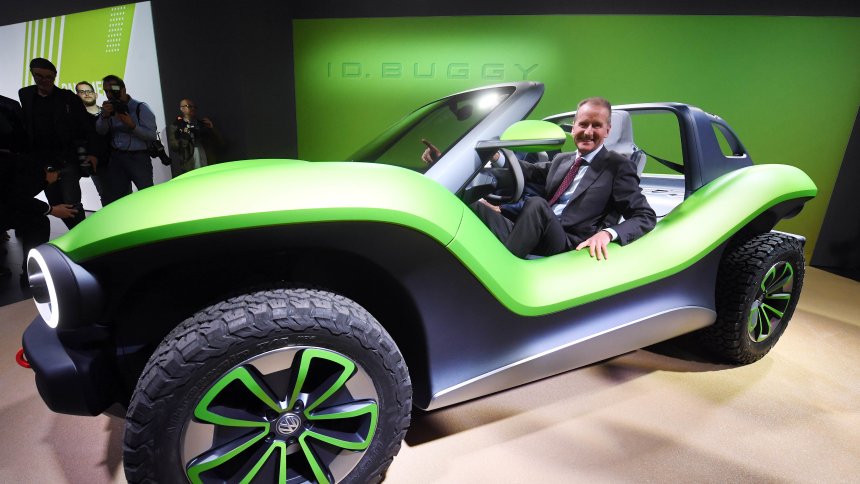Officially, the German automakers have settled their dispute over the mobility of the future. But that is only temporary. For which technology and which company will win, is unclear.
Uli deck / DPA
VW boss Herbert Diess in an electrical ID. buggy
Saturday, 23.03.2019
15:55 clock
Everything was just a misunderstanding. After days of public slugfest, the bosses of the three major automakers had a brief conference call on the phone to to make peace again together with association leader Bernhard Mattes, Herbert Diess (VW), Harald Krüger (BMW) and Dieter Zetsche (Daimler) were quickly agreed, said a VDA spokesman. It was more an exchange than a controversial discussion.
This is remarkable, because the positions were quite different before – and in truth probably still lie.
The dispute broke up had VW boss Diess, with a strategy paper “To better promote the electromobility“Cautiously expressed, rather unilaterally position.” So at least it evaluate industry experts. The policy should focus solely on the electric drivewho are expanding charging infrastructure and using all the financial resources available to make the Stromer affordable for less affluent customers – at the expense of billions of dollars subsidies for the diesel and at the expense of research funding for other alternative propulsion systems such as fuel cell or hybrid.
Lone fighters not asked
In the discussion with his colleagues, it is said, diess back a bit and at least want to include the hybrid now again in the promotion. Details of the agreement would be announced but only in the course of the coming days.
The main reason for the new consensus, however, is more likely to be the insight that lone warriors in the current mixed situation is not a good idea. After scandals about exhaust fraud and unauthorized cartels, the car industry in the public has a very difficult situation. In this situation, society and politics can only win for concepts that are credible and consistent and not already controversial in their own camp.
The problem is, that basically no one can seriously predict which ones Drive technology in the future can fulfill society’s mobility requirements without harming the environment too much.
Each concept has its advantages, but also massive disadvantages. In addition, people in different parts of the world have very different ideas about which drive is best.
Daimler CEO Dieter Zetsche (left) and BMW boss Harald Krüger
From the point of view of BMW CEO Krüger, a group that wants to sell cars anywhere in the world can not afford to neglect a drive variant. In addition, the Munich-based company already has experience of the economic challenges that electric cars hold for their providers. The trendsetting models i3 and i8 have cost billions, which will probably never be reinstated.
Different interests
The same calculation would actually have to apply to VW CEO Diess, says Stefan Bratzel from the University of Applied Sciences in Bergisch Gladbach. After all, the Wolfsburg-based company is also active in many countries and, moreover, still has the brand Audi, which is similarly positioned as Mercedes and BMW.
Nevertheless, it makes sense from Diess’ point of view, at least in Germany alone to rely on the electric drive. Because unlike the competitors from Stuttgart and Munich, the VW group earns its money mainly with cars that are more likely to be in short- and medium-haul traffic. Distances on which the electric motor can bring out its full strength. On the long leg, however, the big saloons of BMW and Mercedes are better with a hybrid drive or with a modern diesel on the way.
Of course it is also good for that golfHowever, the statistics show that the higher mileages are completed in the larger car classes. BMW and Mercedes would be so sensitive, if tax benefits for diesel fell away, which would increase their profitability in maintenance noticeably. Especially the big ones SUVs and limousines will be dependent on diesel for years to come – if only because they are those of the EU fixed fleet limit values for carbon dioxide (CO2) emissions need to reach.
Complicated mixed situation
The conflict between mass producers such as VW on the one hand and the so-called premium manufacturers on the other hand remains at the core therefore. It is only a matter of time before he breaks open again.
Because in the industry no one has anything to give away now – despite the high billions in profits that Daimler and Co. report year after year. But the costs of preparing for the mobility of the future are simply too high. The drive is only a part of it – the cars of the future should also drive autonomously and provide the basis for completely new, previously unknown business models.
However, there is not just a lack of money and ideas for how to manage the enormous costs of structural change. There is also a lack of time. Because the Federal government is after a long phase of laissez-faire against the auto industry have fallen behind in terms of their climate commitments to the EU. The “Future Mobility Platform” set up by the Federal Ministry of Transport has calculated that German CO2 emissions will have to be reduced by more than 40 percent by 2030 in order to meet the requirements of the Paris Climate Agreement. Experts are convinced that this will only be possible if seven to ten million electric cars have been driving on German roads without emissions and the number of new registrations of such vehicles is increasing dramatically.
This mixed situation does not make it easy to reconcile conflicting interests over time and, if necessary, to make painful compromises. Especially as federation president Mattes is not exactly considered a strong moderator who can force the participants to concessions if necessary.
And someone like this is guaranteed to be one of those who, in times of need, sometimes push others aside.


